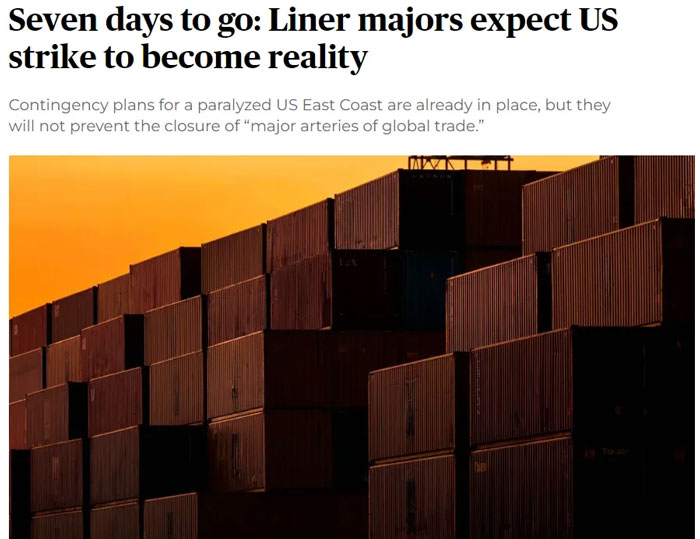

Us East Coast ports face a strike, shipping giants make contingency plans
Liner giants have warned that an impending strike at US East Coast ports could become a reality, a development that would significantly affect global trade in the coming week. If a strike takes place, East Coast ports could grind to a halt, stranding thousands of fully loaded containers and escalating the conflict between dockworkers and their employers.
Shipping companies such as Germany's Hapag-Lloyd and Norwegian car transport giant Wallenius Wilhelmsen have drawn up contingency plans aimed at minimising potential disruption to their supply chains and operations. However, Mike DeAngelis, director of international solutions at research firm FourKites, pointed out that even the best of these plans would not change the fact that a strike would "choke off a major artery of global trade." He further warned that even after the strike ended, the backlog could lead to delays of weeks or even months.
At the heart of the strike is a dispute over the impact of increased automation at ports on jobs. Harold Daggett, chairman of the ILA, believes that automation has led to an outflow of money to foreign shipping companies, which in turn has triggered job losses for American workers. In the face of the impasse, companies such as Hapag-Lloyd have anticipated the possibility of a strike and imposed a surcharge of $1,000 per TEU for shipments to the US East Coast. In fact, CMA CGM, MSC, HMM have issued a notice that the corresponding surcharge will be imposed in October.
The strike will not only hit the US economy, but could also have a profound impact on global trade. Low water levels in the Panama Canal, security risks in the Suez Canal, and potential strikes at East Coast ports have combined to create a "perfect storm" that has created unprecedented challenges for global shipping. Shippers have taken steps in advance to mitigate the potential impact by adjusting routes, but experts predict that the backlog after the strike will persist for a long time and could even reshape the shipping landscape for years to come.
In addition, shippers may be forced to turn to Canada and the West Coast ports of the United States, but these ports also face busy and delayed issues. Shipping companies and alliances are taking precautionary measures, such as cancelling some port calls and unloading at others, to ensure timely clearance of cargoes.
At the political level, although US President Joe Biden has been called to intervene in mediation, the government has said it will respect the negotiating process and has not explicitly said it will use legal means to intervene. However, shipping analysts and sources pointed to the possibility that the Federal Maritime Commission (FMC) could step in to mediate at the request of both parties.
Taken together, the potential strike at US East Coast ports has caused widespread concern in the global shipping industry. All parties are closely monitoring the situation and taking measures to mitigate the potential impact. However, the final outcome of the strike remains uncertain and could have far-reaching implications for the global economy and trade.
Shipping companies such as Germany's Hapag-Lloyd and Norwegian car transport giant Wallenius Wilhelmsen have drawn up contingency plans aimed at minimising potential disruption to their supply chains and operations. However, Mike DeAngelis, director of international solutions at research firm FourKites, pointed out that even the best of these plans would not change the fact that a strike would "choke off a major artery of global trade." He further warned that even after the strike ended, the backlog could lead to delays of weeks or even months.

At the heart of the strike is a dispute over the impact of increased automation at ports on jobs. Harold Daggett, chairman of the ILA, believes that automation has led to an outflow of money to foreign shipping companies, which in turn has triggered job losses for American workers. In the face of the impasse, companies such as Hapag-Lloyd have anticipated the possibility of a strike and imposed a surcharge of $1,000 per TEU for shipments to the US East Coast. In fact, CMA CGM, MSC, HMM have issued a notice that the corresponding surcharge will be imposed in October.
The strike will not only hit the US economy, but could also have a profound impact on global trade. Low water levels in the Panama Canal, security risks in the Suez Canal, and potential strikes at East Coast ports have combined to create a "perfect storm" that has created unprecedented challenges for global shipping. Shippers have taken steps in advance to mitigate the potential impact by adjusting routes, but experts predict that the backlog after the strike will persist for a long time and could even reshape the shipping landscape for years to come.
In addition, shippers may be forced to turn to Canada and the West Coast ports of the United States, but these ports also face busy and delayed issues. Shipping companies and alliances are taking precautionary measures, such as cancelling some port calls and unloading at others, to ensure timely clearance of cargoes.
At the political level, although US President Joe Biden has been called to intervene in mediation, the government has said it will respect the negotiating process and has not explicitly said it will use legal means to intervene. However, shipping analysts and sources pointed to the possibility that the Federal Maritime Commission (FMC) could step in to mediate at the request of both parties.
Taken together, the potential strike at US East Coast ports has caused widespread concern in the global shipping industry. All parties are closely monitoring the situation and taking measures to mitigate the potential impact. However, the final outcome of the strike remains uncertain and could have far-reaching implications for the global economy and trade.





